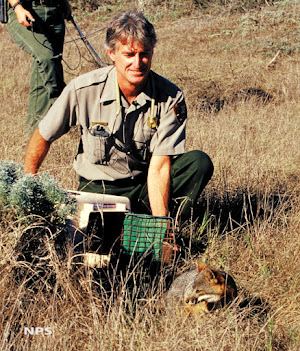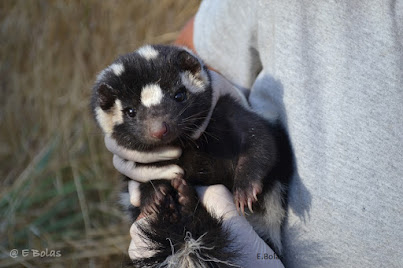Island fox populations are healthy, but the differences between each island subspecies are becoming more apparent.
The following is the update from across the Channel Islands as compiled from notes by Friends of the Island Fox at the 25th Annual Island Fox Working Group Meeting held May 18, 2023 at the Santa Barbara Zoo (hybrid meeting).
Reported population numbers are official estimates from each land manager as calculated during the 2022 counting period. (How are island foxes counted)
Overview: Island foxes appeared healthy across the islands, but while some populations increased toward near record highs, others declined. Increasingly, island fox populations are revealing different health risks, climate impacts, and island specific challenges.
Microbiome research. Each island ecosystem effects the natural bacteria of its island fox population. Three islands have ear mites: Nicolas, Clemente, and Catalina. Both Clemente and Catalina Island foxes have reduced bacterial biodiversity, but only Catalina Island foxes develop chronic inflammation in conjunction with out of balance bacteria and develop cancer if ear mites are not treated. More about microbiome research
Island fox life span may vary by island. The age of many island foxes is documented because most individuals are microchipped. In 2022, two island foxes on San Miguel Island died naturally of old age at 11 and 12 years old. At the same time, the oldest island fox captured on San Nicolas Island was 9. Santa Rosa currently has the greatest density of island foxes and collared foxes that died during the year were 2–7 years old. Island fox life span may be influenced by multiple variables. Determining age from tooth cementum
Island size influences fox population limits. Smaller islands, like San Miguel and San Nicolas can only support 300–450 island foxes. When drought, catastrophic heatwaves, or other survival challenges occur, these smaller populations are more vulnerable to loss.
The leading threats to island foxes in 2023 are:
- biosecurity: the threat of introduced viruses, disease, and/or non-native animals
- reduced funding for monitoring
- climate change: increasing regional temperatures and decreasing annual rainfall, which reduce resources, increase wildfire, and promote greater parasite numbers
Greatest Concern: While other island fox populations remained stable or even increased, San Clemente Island foxes declined by an estimated 30%, without a known cause. Individual island foxes on San Clemente appear healthy and pups were documented in numbers similar to other islands. This decline is being investigated; it's a strong reminder that these island populations are vulnerable and can be effected quickly by a negative force.
Disease threats remain high for all island foxes. As populations reach carrying capacity and island foxes live closer together, it becomes easier for viruses to pass from fox-to-fox. Friends of the Island Fox is responding to this increased concern by supporting canine distemper and rabies vaccinations across four islands in 2023.
You can help protect island foxes by being a biosecurity guardian; watch the video
Smaller Islands
The two smallest islands San Miguel and San Nicolas remain stable, but you can see in the graph above that the trend was completely different on San Clemente Island.
San Miguel Island (lime green line) - This population continues to increase from a drought impact low in 2018. In 2022, an individual island fox on San Miguel had an 82% chance of surviving the year, the highest survival rate reported across the islands for the year.
San Nicolas Island (pink line) - Easing drought also benefited San Nicolas Island foxes and their individual health improved. However, island foxes have begun congregating in areas where people offer food. As a result Adenovirus (dog flu) and Parvovirus are spreading and increasing across the island; fortunately, no fatalities have been attributed to the diseases. Being hit by a car remains the greatest threat to these island foxes. FIF is working with the Navy on an education program to reduce this threat.
San Clemente Island (blue line) - The population dropped lower than it has been since 2008. Car strike is especially frequent on this island–42 fatalities in 2022–with the majority being young foxes. This, however, doesn't account for the overall decline. Researchers are evaluating the survival rate for pups and other potential causes.
Larger Islands
The current population sizes of the larger islands have helped provide greater stability and resilience against climate change impacts. All of the island fox populations on the larger islands are at or near documented population highs.
Santa Catalina Island (red line) - Catalina Island foxes benefited from easing drought; their general health improved and viruses in the population declined. Currently, human activity poses the greatest threat. Not only are island foxes hit by cars, they get trapped in man-made structures and are killed by pet dogs. Catalina has the greatest threat of canine distemper or rabies being introduced. FIF funded vaccinations for 350 island foxes on this island and health testing.
Santa Rosa Island (pink line with squares) - This island currently has the greatest known island fox density, with 12.4 foxes per sq km. The calculated rate for an individual to survive the year declined to 75%, but the population remained unchanged. While several collared foxes aged 2–7 died during the year, the cause of death remains unknown because of a lack of staffing in the National Park to recover the bodies for testing. The two GPS radio collar studies of island fox territory supported by Friends of the Island Fox continue. Data should be available later this summer.
Santa Cruz Island (black line) - Santa Cruz Island has the largest island fox population, but increasing competition has edged down the chance of an individual island fox surviving through the year to 55%. Still, island foxes appear healthy. Ten sentinel foxes died during the winter, but their bodies were not recovered for testing due to stormy weather.
Across the Channel Islands, island foxes are stable and healthy because people like you are investing in their future. Your donations to Friends of the Island Fox fund vaccinations, radio collars for monitoring, health efforts, education, and important research.



















































